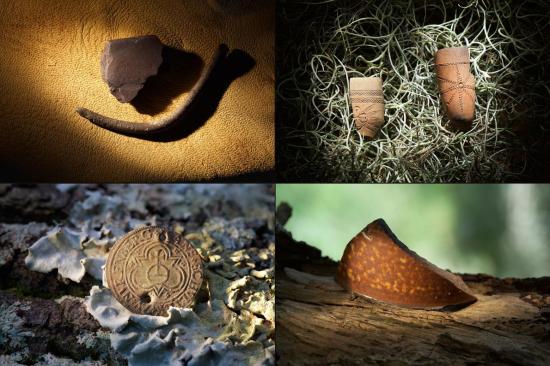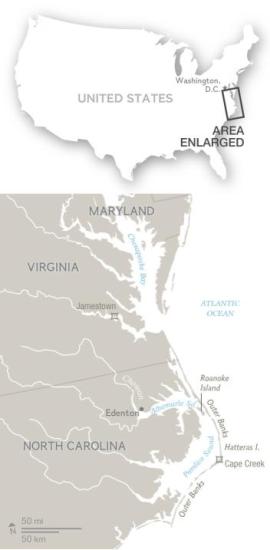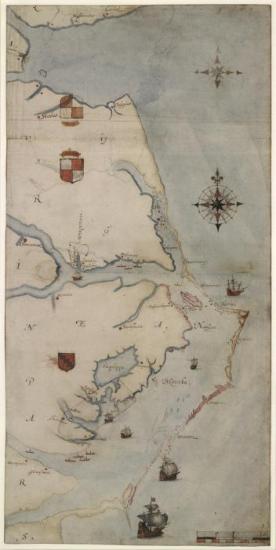Artifacts suggest some members of ill-fated English settlement survived and assimilated with Native Americans
Andrew Lawler
Source - http://news.nationalgeographic.com/2015/08/150807-lost-colony-roanoke-hatteras-outer-banks-archaeology/
 European artifacts, including (clockwise from top left) pieces of a slate writing tablet, clay tobacco pipes, a stoneware vessel, and a German token could help pinpoint where colonists retreated after abandoning Roanoke Island, North Carolina. PHOTOGRAPH BY MARK THIESSEN, NATIONAL GEOGRAPHIC
European artifacts, including (clockwise from top left) pieces of a slate writing tablet, clay tobacco pipes, a stoneware vessel, and a German token could help pinpoint where colonists retreated after abandoning Roanoke Island, North Carolina. PHOTOGRAPH BY MARK THIESSEN, NATIONAL GEOGRAPHIC
The search began when an anxious Englishman named John White waded ashore on North Carolina’s Roanoke Island 425 years ago this month. Appointed governor of the fledgling Roanoke colony by Sir Walter Raleigh, White was returning from England with desperately needed supplies.
But when he stepped ashore on August 18, 1590, he found the settlement looted and abandoned. The vanished colonists had left behind only two clues to their whereabouts: the word “Croatoan” carved on a prominent post and “Cro” etched into a tree.
 Ever since, explorers, historians, archaeologists, and enthusiasts have sought to discover the fate of the 115 men, women, and children who were part of England’s first attempt to settle the New World. Efforts to solve America’s longest running historical mystery, dubbed the Lost Colony, produced dozens of theories but no clear answers.
Ever since, explorers, historians, archaeologists, and enthusiasts have sought to discover the fate of the 115 men, women, and children who were part of England’s first attempt to settle the New World. Efforts to solve America’s longest running historical mystery, dubbed the Lost Colony, produced dozens of theories but no clear answers.
Now two independent teams say they have archaeological remains that suggest at least some of the abandoned colonists may have survived, possibly splitting into two camps that made their homes with Native Americans.
A collection of newly discovered European objects, including a sword hilt, broken English bowls, and a fragment of a slate writing tablet still inscribed with a letter, could point to the presence of the colonists on Hatteras Island, some 50 miles (80 kilometers) southeast of their settlement on Roanoke Island, as well as at a site on the mainland 50 miles to the northwest.
“The evidence is that they assimilated with the Native Americans but kept their goods,” says Mark Horton, an archaeologist at Britain’s Bristol University, who heads the excavation on Hatteras.
Meanwhile, at the mainland site on the Albemarle Sound near Edenton, N.C., Nick Luccketti of the First Colony Foundation believes that his group has unearthed pottery used by the lost colonists after they deserted their Roanoke settlement.
Members of both teams admit they can’t yet claim to have solved the vexing riddle. And many of their colleagues are skeptical that the artifacts can be definitively tied to the ill-fated colonists, given difficulties in dating them precisely.
“You have more work to do,” warned Ivor Noel Hume, a former Colonial Williamsburg archaeologist who excavated at Roanoke Island in the 1990s. Hume met with Horton and Luccketti last month to discuss their finds.
But the digs signal an important shift away from Roanoke Island, where researchers have found frustratingly few signs of an early European presence.
 Governor John White’s 1585 map of the area from today’s Cape Henry, Virginia, to Cape Lookout, North Carolina, was remarkably accurate. In 2012 researchers discovered a symbol hidden beneath a patch that may have marked the location of a fort. © THE TRUSTEES OF THE BRITISH MUSEUM
Governor John White’s 1585 map of the area from today’s Cape Henry, Virginia, to Cape Lookout, North Carolina, was remarkably accurate. In 2012 researchers discovered a symbol hidden beneath a patch that may have marked the location of a fort. © THE TRUSTEES OF THE BRITISH MUSEUM
PART.2